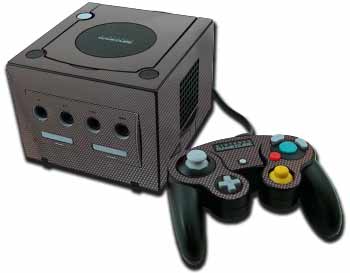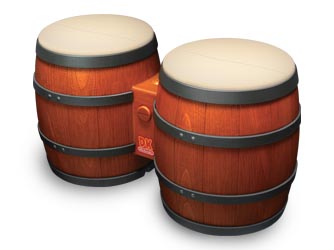Game Cube Mario games!
|
|
Game Cube console!
The Nintendo GameCube is Nintendo's fourth home video game console, belonging to the sixth generation era. The GameCube itself is the most compact and least expensive of the sixth generation era consoles. The GameCube was released on September 14 , 2001 in Japan ; November 18 , 2001 in North America ; May 3 , 2002 in Europe ; and May 17 , 2002 in Australia .

The GameCube was unveiled on 24 August 2000 , one day before Nintendo's SpaceWorld trade show. Shaped roughly like a cube , the console is available in a variety of colors, such as indigo, platinum, and black (also a limited edition Resident Evil 4 platinum and black game console). In Japan, the system is also available in Spice (orange), or in limited edition colors like Crystal White, Mint Green, Copper, and White with black pinstripes.
The Nintendo GameCube uses a proprietary storage medium, the Nintendo GameCube Game Disc , based on Matsushita 's optical-disc technology; the discs are approximately 8 centimeters (3 1/8 inches) in diameter (considerably smaller than the 12 cm CDs or DVDs used in competitors' consoles), and have a capacity of approximately 1.5 gigabytes . Contrary to popular belief, GameCube discs are not physically read any differently from a standard DVD disc, but are encrypted with a key derived from the Burst Cutting Area, a 'bar code' unreadable by most DVD drives. This move was intended to prevent unauthorized copying of GCN titles, but was eventually cracked . By exploiting a flaw in Phantasy Star Online Episode I & II , users were able to connect their GameCubes to their PCs and run homebrew programming on the console.
The Nintendo GameCube does not have DVD or audio CD support, but Matsushita 's Panasonic Q (described below), only available in Japan, does. Common reasons cited by Nintendo for using this format are to reduce copyright infringement, provide faster loading times, make the system cheaper by avoiding DVD-licensing fees, and allow smaller discs. The lack of DVD movie support was a double-edged sword; it did not appeal to the mass audience that turned to the PlayStation 2 and Xbox due to their built-in DVD support. A number of games with large amounts of audio or video were scaled down when ported to the GameCube. [ citation needed ] Despite the protection of a non-standard disc format (essentially a miniature DVD-ROM with non-standard sectors and filesystem formatting), a number of modchips such as the Qoob and ViperGC have been released that, when used in conjunction with a modified BIOS , allow the use of a standard or 8 cm DVD-R to load backed-up , homebrew , bootleg or copied software . The Panasonic Q , released by Panasonic in Japan under license from Nintendo, is manufactured as a modified GameCube unit with added DVD and audio CD playback functionality. It was never released outside of Japan; production ceased in December 2003. Differences in design make the Panasonic Q incompatible with the Game Boy Player . However, the Panasonic Q Game Boy Player was released to address the problem of the extended pegs on the bottom, allowing play of Game Boy games.
The GameCube can connect to a Game Boy Advance or Game Boy Advance SP to transfer game data. The GameCube can also connect to a Game Boy Micro , but the cable required to connect the two must be custom made since it has not been otherwise made available. Examples of this functionality include the use of the Game Boy Advance as a controller for the game played. Information related to game play may be displayed on the Game Boy Advance's color screen for added convenience or to avoid the cluttering of the display on the television screen. This functionality has been used to unlock bonuses such as new levels or characters when certain Game Boy Advance and GameCube games are connected together. Up to four Game Boy Advance systems can be connected to the GameCube through the GameCube's four controller ports for multiplayer play. A Nintendo GameCube-Game Boy Advance cable is required for each system that is connected to the GameCube. However, this required a user to buy a GameCube, a Game Boy Advance, and the GameCube version of the title, along with the Game Boy Advance version. Some GameCube titles only used the Game Boy Advance as a screen and did not require a separate Game Boy Advance game.
The GameCube can also connect directly to another GameCube for LAN play. Another television is needed for the second console. The Gamecube can connect over LAN with up to eight other GameCubes.
The GameCube was designed for portability, with its small size complemented by a carrying handle. However, this feature over other consoles was minimal since its inexpensive production and selling price were its main advantages. Despite being more compact than the original PlayStation 2 model (it was released over a year later and kept the power supply separate from the console), the GameCube has overall superior graphics processing power and better Pro Logic sound , but no optical output. The GameCube has a front end menu system which can be accessed by holding the 'A' button while the system boots or by booting with no game inserted. This menu controls settings for memory card data, sound, and the internal clock.
The controller has the traditional directional pad, two analog sticks, and eight buttons: A, B, X, Y, Z, L, R, and pause/start. Like the Nintendo 64 controller , it features no select button. The C buttons have been replaced by an analog C stick. The analog sticks do not have added "clickable" button functionality—unlike other such consoles of the era—but both L and R shoulder buttons are analog, able to detect pressure applied to them before "clicking," essentially doubling their functionality.
Nintendo released a network adapter for the GameCube during the Christmas season of 2002, but did not promote or support online gaming as heavily as Sony or Microsoft. Two adaptors were released: the Nintendo GameCube Modem Adapter for dial-up and the Nintendo GameCube Broadband Adapter for broadband. The only high-profile title that requires the adapter is Sega's Phantasy Star Online Episode I & II . Instead, Nintendo focused more on Game Boy Advance connectivity.

First-Party and Officially Licensed Accessories/peripherals
- Controller (Standard colors include Indigo, Black, Spice (Orange), Platinum and Indigo-clear). There are also many limited edition controllers available such as a split blue and red, with the Mario "M" logo replacing the regular GameCube logo seen on standard controllers (there have also been green and blue Luigi "L" controllers and similarly yellow and pale blue Wario "W" controller). There are also specially shaped controllers.
- WaveBird ( RF wireless controller)
- Memory Card 59 (4Mb), 251 (16Mb) or 1019 (64Mb) blocks, with a maximum of 127 files can be stored on a single card
- Nintendo GameCube-Game Boy Advance cable (for games that support connectivity between the GameCube and the Game Boy Advance)
- Modem or Broadband adapter (for internet or LAN play) both of which connect to the Serial Port 1
- Game Boy Player (to play Game Boy games on the television, using either a GameCube controller or a connected Game Boy Advance) which connects to the Hi Speed Port
- Component video cable (for progressive scan ( 480p ) support) which requires a GameCube with Digital Video Output. Less than one percent of GameCube owners used 480p; therefore the digital output was eventually removed from the design to reduce the system's manufacturing costs. (See System Specifications above and Official Information .)
- D-Terminal Video Cable - allows Progressive Scan mode to be enabled through a D-Terminal port on a TV. It was sold in Japan only. An analog A/V cable is still required for audio.
- RGB Cable - provides a better quality picture than composite cables. It utilizes the SCART connector standard and is sold in Europe only.
- S-Video Cable - provides a better quality picture than composite cables, although not up to that of the RGB Cable . Only NTSC Gamecubes could use the S-Video cable.
- VGA Adapter - allows GameCube play on a standard computer monitor. A game supporting 480p combined with the Component Video cable above, and the VD-Z3 (which has a monitor pass-through) can give progressive scan display quality on a computer monitor.
- In PAL regions, an RF cable for connection to older televisions.
- RF Switch in NTSC regions for connection to older televisions. Essentially a NES RF box with a matching unit attached to fit the multi-out of the Game Cube.
- DK Bongos for use with the music games Donkey Konga , Donkey Konga 2 and Donkey Konga 3 , the Donkey Kong platform title Donkey Kong Jungle Beat , and the soon-to-be released racing game DK Bongo Blast .

- Microphone , which plugs into memory card slot, for use with Mario Party 6 , Mario Party 7 , and Karaoke Revolution Party . Odama also includes a microphone clip to clip on to the controller. Commands are issued when you hold the X button on the controller.
- SD Card Adapter, for games exhibiting the SD Card logo like Animal Forest e+ . This official Nintendo accessory is currently sold in Japan only.
- A dance pad , included with Dance Dance Revolution: Mario Mix . It has 4 arrows.
- A Beat Pad made by Mad Catz and officially licensed by Nintendo, included with the game MC Groovz Dance Craze . Also sold separately. It has 8 arrows.
- An ASCII keyboard controller, resembling a standard GameCube controller pad stretched to accommodate an alphanumeric keyboard in the center. The keyboard requires the use of two controller ports, and contains both Roman and Japanese hiragana characters. It is considered particularly useful for Phantasy Star Online Episode I & II and is difficult, though not impossible, to acquire outside of Japan. A cheaper and easier keyboard to import is made by Datel , although most people opt to purchase just an adapter so they can use their own PC keyboards.
- Hori Game Boy Player Controller - A controller designed to play with the Game Boy Player. It only came in the colors Indigo and Jet Black. The controller is in the shape of a Super Nintendo control pad. It does not include the Control Stick or C-Stick, and the R and L buttons lack a range of pressure sensitivity; thus, only uses the D-Pad for movement and the usual buttons for playing. They were released only in Japan, and are officially licensed Nintendo products. Although meant for the Game Boy Player , this pad can still be used with certain 2-D GameCube games, such as Alien Hominid or the Mega Man collections.
- Logitech Speed Force Racing Wheel - An officially licensed force feedback steering wheel made exclusively for the GameCube. It is supported by a number of games, including F-Zero GX, R: Racing Evolution, Mario Kart: Double Dash!, Burnout 2, and the Need for Speed series, among others. There is also an optional accessory pack which includes foot pedals and a lap attachment.
- ProDG , an officially licensed development tool for the GameCube. In a photo from the product's home page at [8] , the cable appears to be protruding from the left side of the case where the Serial Port 2 should be. If this does connect to that port, this would be the only accessory known to do this.

